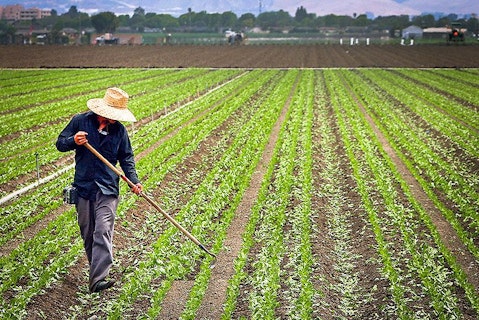In this article, we will be taking a look at the 10 best vertical farming and hydroponic stocks to buy. To see more of these stocks, you can go directly to see the 5 Best Vertical Farming and Hydroponic Stocks to Buy.
The agriculture and farming sector has long been a vital part of not only financial markets but also day-to-day living for the global population. With global food insecurity being on the rise in recent years, this sector has become even more important and, thus also more burdened. To meet rising demand, increasingly dangerous agricultural practices have been adopted in the past, which have been taking an immense toll on the planet. Many climate change activists thus place the blame on agricultural practices for many current issues such as climate change, deforestation, and soil degradation. Because of this, innovations within the agriculture sector that enable sustainable, environmentally friendly, and affordable crop production have become necessary. Two such innovations are what we know as vertical and hydroponic farming.
What are Vertical and Hydroponic Farming?
Simply put, vertical farming is farming on vertical surfaces rather than horizontal surfaces. In this method, vertically stacked layers are used to enable farmers to produce more food on the same amount of land, if not less. In many cases, vertical farming is integrated into buildings such as greenhouses and even skyscrapers. However, much more accommodation has to be made for crops being grown with such a method. For instance, farmers have to ensure their crops have enough artificial temperature, light, and water. As such, the area where vertical farming is operative is almost highly controlled by experienced professionals to ensure no crops are lost or wasted.
Many agricultural and farming companies, such as Deere & Company (NYSE:DE), The Mosaic Company (NYSE:MOS), and Archer Daniels Midland Company (NYSE:ADM) have been focusing on sustainable agricultural practices. However, the companies operating directly within the vertical farming and hydroponics space have been leading the agricultural sector in terms of sustainability. Like vertical farming, hydroponic farming is another sustainable agricultural practice. In this method, farmers grow their plants using a water-based nutrient solution instead of soil. This agricultural practice has actually been around for a long time, so it’s not exactly a new innovation. According to the US Department of Agriculture (USDA), the process of growing plants in water culture or sand culture without soil is actually one that has been used by physiologists for over a century. However, with the means and technology utilized by companies working in this space today, the scope and effectiveness of this agricultural practice have grown to greater lengths than ever before.
American Support for Innovative Agriculture
The USDA has long been committed to increasing the scope of urban and innovative agricultural production on a local level. In 2021, the department announced a grant of $4 million to support this initiative. The 2021 grant was the second of its kind offered by the US government for this purpose, and it spanned two kinds of projects: Planning Projects and Implementation Projects.
Under the first category, the USDA attempted to encourage farmers, gardeners, citizens, government officials, schools, and any other stakeholders in urban and suburban areas to initiate projects targeting key areas of food access and more. Under the second category, the department aimed to accelerate the growth and progress of existing urban, indoor, and other agricultural practices to improve local food access.
The grants offered by the government in the past were only succeeded by even more generous opportunities in 2022. In October, the USDA again announced that it was investing $14.2 million in 52 grants to support urban agriculture and innovative production. This move was meant to expand the population’s access to nutritious foods and increase awareness of climate change, and the money promised in these grants further built on $26.3 million already invested in similar projects since 2020. Such stringent and enthusiastic efforts on the part of the government have managed to make vertical and hydroponic farming more widely practiced across the country and spell out only good news for the companies operating within this space. As such, we have compiled a list of some of the best vertical farming and hydroponic stocks to buy today since they may well skyrocket sometime in the near future.

Pixabay/Public Domain
Let’s now take a look at the 10 best vertical farming and hydroponic stocks to buy.
Our Methodology
To select the stocks for our list below, we used Insider Monkey’s hedge fund data for the fourth quarter, when 943 hedge funds were tracked. The stocks below are thus among the vertical farming and hydroponic stocks that many elite hedge funds are piling into today. We have ranked the stocks based on this metric, from the lowest to the highest number of hedge funds holding stakes in them. The data on each stock’s upside potential mentioned in the list below has been obtained from TipRanks.
Best Vertical Farming and Hydroponic Stocks to Buy
10. urban-gro, Inc. (NASDAQ:UGRO)
Number of Hedge Fund Holders: 1
urban-gro, Inc. (NASDAQ:UGRO) is an agricultural stock working to design, engineer, build, and integrate complex environmental equipment systems for indoor controlled environment agriculture. The company considers itself a truly integrated Design Build provider working in the vertical farming space.
On March 31, Maxim analysts reiterated a Buy rating on urban-gro, Inc. (NASDAQ:UGRO) shares.
The average price target placed on urban-gro, Inc. (NASDAQ:UGRO) is $7.50, and the shares were trading at $1.90 on May 1. This gives the stock an upside potential of 294.74%. Wall Street analysts view urban-gro, Inc. (NASDAQ:UGRO) as a Strong Buy, with there being three Buy ratings placed on the stock.
Citadel Investment Group was the largest shareholder in the company at the end of the fourth quarter, holding 15,131 shares. There was one hedge fund long the stock, with a total stake value of $41,000.
urban-gro, Inc. (NASDAQ:UGRO), like Deere & Company (NYSE:DE), The Mosaic Company (NYSE:MOS), and Archer Daniels Midland Company (NYSE:ADM), is a farming stock with immense potential.
9. iPower Inc. (NASDAQ:IPW)
Number of Hedge Fund Holders: 1
iPower Inc. (NASDAQ:IPW) is an online retailer and supplier of hydroponics equipment and accessories. It is based in Duarte, California.
Analysts see iPower Inc. (NASDAQ:IPW) as a Moderate Buy, with one Buy rating placed on the stock. In the fiscal second quarter of 2023, the company generated revenues of $19.25 million. This represents a revenue growth rate of 12.43% year-over-year. iPower Inc. (NASDAQ:IPW) also has an immensely low EV/Sales multiple of 0.37 (TTM). This shows the undervaluedness of the company relative to its potential.
One shareholder was long iPower Inc. (NASDAQ:IPW) in the fourth quarter, with a total stake value of $10,000.
8. Agrify Corporation (NASDAQ:AGFY)
Number of Hedge Fund Holders: 3
Agrify Corporation (NASDAQ:AGFY) is an agricultural company offering vertical farming units and Agrify Insights Software-as-a-Service software. It is based in Billerica, Massachusetts.
Agrify Corporation (NASDAQ:AGFY) is currently deeply undervalued relative to its potential since the stock has an EV/Sales multiple of 0.47 (TTM). The stock is up by 43.75% over the past month as of May 1. Agrify Corporation (NASDAQ:AGFY) has a gross profit margin of 9.39%.
Alyeska Investment Group was the largest shareholder in the company at the end of the fourth quarter, holding 1.2 million shares. In total, three hedge funds were long the stock, with a total stake value of $419,000.
7. Kalera PLC (OTCMKTS:KALRQ)
Number of Hedge Fund Holders: 4
Kalera PLC (OTCMKTS:KALRQ) is a hydroponic vertical farming company based in Orlando, Florida. It operates vertical hydroponic farms and similar technology development facilities to produce lettuce and micro-greens for the retail and food service markets.
This January, Kalera PLC (OTCMKTS:KALRQ) announced plans to achieve 74% cost savings by the end of 2023. It intends to operate its Houston and Denver farms at near-capacity levels to ensure these farms keep generating profits. Through 2023, Kalera PLC (OTCMKTS:KALRQ) expects its general and administrative expenses and operating losses to also fall by 65% compared to 2022.
Four hedge funds were long Kalera PLC (OTCMKTS:KALRQ) in the fourth quarter. Their total stake value was $6,000.
6. Village Farms International, Inc. (NASDAQ:VFF)
Number of Hedge Fund Holders: 5
Village Farms International, Inc. (NASDAQ:VFF) is a controlled environment agriculture-based, vertically integrated supplier of plant-based consumer packaged goods opportunities. It is based in Delta, Canada.
Shares of Village Farms International, Inc. (NASDAQ:VFF) were trading at $0.77 on May 1. The average price target placed on the stock by analysts on Wall Street is $2.31, with a high forecast of $3. This gives the stock an upside potential of 202%. Analysts also see Village Farms International, Inc. (NASDAQ:VFF) as a Moderate Buy since there are two Buy ratings and two Hold ratings on the stock.
Bourgeon Capital was the largest shareholder in the company at the end of the fourth quarter, holding 2,000 shares. A total of five hedge funds were long the stock, with a total stake value of $815,000.
Village Farms International, Inc. (NASDAQ:VFF), like Deere & Company (NYSE:DE), The Mosaic Company (NYSE:MOS), and Archer Daniels Midland Company (NYSE:ADM), is a farming stock many analysts view as a lucrative investment.
Click to continue reading and see the 5 Best Vertical Farming and Hydroponic Stocks to Buy.
Suggested articles:
- 10 Best Organic Food and Farming Stocks To Buy
- 14 Best Agriculture Stocks To Buy Now
- 11 Best Agriculture Stocks To Buy Now
Disclosure: None. 10 Best Vertical Farming and Hydroponic Stocks to Buy is originally published on Insider Monkey.


